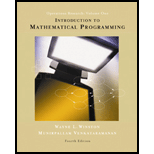
Chapter 3.5, Problem 3P
Formulation of LP:
Let,
x1= Number of employees who start work on Sunday and work 5 days.
x2= Number of employees who start work on Monday and work 5 days.
x3= Number of employees who start work on Tuesday and work 5 days.
x4= Number of employees who start work on Wednesday and work 5 days.
x5= Number of employees who start work on Thursday and work 5 days.
x6= Number of employees who start work on Friday and work 5 days.
x7= Number of employees who start work on Saturday and work 5 days.
y1= Number of employees who start work on Sunday and work 5 days.
y2= Number of employees who start work on Monday and work 5 days.
y3= Number of employees who start work on Tuesday and work 5 days.
y4= Number of employees who start work on Wednesday and work 5 days.
y5= Number of employees who start work on Thursday and work 5 days.
y6= Number of employees who start work on Friday and work 5 days.
y7= Number of employees who start work on Saturday and work 5 days.
Then the appropriate LP is given below,
Minimize, z = 250(x1+x2+x3+x4+x5+x6+x7) + 312(y1+y2+y3+y4+y6+y7)
Subject to the constraints,
x1+x4+x5+x6+x7+y1+y3+y4+y5+y6+y7≥11 (Sunday)
x1+x2+x5+x


 Operations Research : Applications and AlgorithmsComputer ScienceISBN:9780534380588Author:Wayne L. WinstonPublisher:Brooks Cole
Operations Research : Applications and AlgorithmsComputer ScienceISBN:9780534380588Author:Wayne L. WinstonPublisher:Brooks Cole